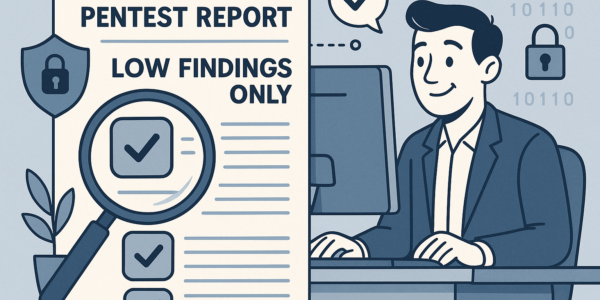Imagine you just received your penetration test report. You scroll down and see only a couple of low-severity issues — maybe a clickjacking vulnerability or a misconfigured HTTP header. No critical bugs. No SQL injection. No exposed admin portals.
Should you be relieved? Happy? Or maybe… a little concerned?
⸻
What Low or No Findings Do Mean:
• Your application has passed a basic hygiene check — no obvious doors left wide open.
• You’ve likely already implemented some best practices: input validation, basic access controls, patched frameworks.
• Your software development lifecycle (SDLC) may already include code reviews, secure coding, and testing — all of which help reduce risk.
That’s good. You should feel proud.
⸻
But Here’s the Trap:
A clean pentest report doesn’t mean you’re safe.
It simply means that, at the time of testing, no obvious flaws were exposed — or perhaps the tester didn’t uncover the ones that exist.
Pentesting is not a guarantee of invulnerability. Like any assessment, it depends on the scope, methods, tools and the experience of the tester.
⸻
A Few Reasons Why Low Findings ≠ Immunity:
1. Pentests Have a Scope
• Most pentests are time-boxed.
• We test what we’re allowed to, if an endpoint or function is out of scope, it’s not tested — even if that’s where the real risk lies.
2. Attackers Have Unlimited Time
• Unlike ethical hackers, attackers don’t stop when time’s up.
• They use social engineering, phishing, leaked credentials and supply chain attacks — often out of scope for standard pentests.
3. “Low” Today Can Be “High” Tomorrow
• That simple clickjacking issue? Combine it with a clever CSRF trick, and you’ve got a session takeover
• A low-risk file upload flaw might seem harmless—until someone chains it with a MIME filter bypass to upload a PHP or JavaScript file to an accessible directory.
Vulnerabilities can be chained together, turning individually “low” findings into a serious breach. Read more about chaining vulnerabilities here.
4. Security Is Not a One-Off Event
• Pentesting is a snapshot, not a guarantee. Do not believe that you won’t get breached after a pentest exercise.
• Apps change. APIs evolve. Devs deploy.
• New libraries, zero-day vulnerabilities, and misconfigurations emerge all the time.
⸻
“Our Pentest Will Be Done in 3 Days” — Efficient or a Value Trap?
Sometimes you’ll hear a pentesting provider say,
“We can complete your pentest in just 3 days.”
It might sound impressive — but it’s worth asking:
• Are they doing manual testing, or just running automated scans?
• Have they scoped your application properly — including APIs, authentication flows and business logic?
• Are they spending time exploring real-world exploit or just checking boxes?
A quality pentest takes time, context and creativity. Rushing through it risks missing the very vulnerabilities that real attackers exploit.
So if a provider promises a very short testing window, it doesn’t necessarily mean they are efficient — it might mean they are superficial.
⸻
What You Should Do After a “Clean” Report
A clean report is a great sign, but it doesn’t mean you’re unbreakable — or that your application is flawless.
For your next round of pentesting, consider switching vendors.
Different testers bring different tools, perspectives and techniques. What one team misses, another might catch. A fresh set of eyes can make all the difference. Read more here.
⸻
How Perennial Consultancy Approaches Penetration Testing
At Perennial Consultancy, we don’t just run automated tools and call it a day.
We take time to understand:
• Your business logic
• How real attackers would approach your app
• Which combinations of seemingly “low-risk” issues could escalate into something serious
Our pentesting approach is:
✅ Focus on manual tests
✅ Balanced with CVSS scoring, but focused on real-world exploitability
✅ Not generic but designed to uncover and exploit vulnerabilities based on your unique risk landscape.
✅ Aligned with MAS TRM expectations for fintech and regulated industries in Singapore
⸻
Final Thought
Too often, companies treat penetration testing as just a checkbox for regulatory compliance, opting for the lowest-cost option just to meet the requirement. But security isn’t about ticking boxes — it’s about protecting your business from real-world threats.
Because when a breach happens, the impact isn’t just financial.
It’s your brand, reputation, and customer trust on the line.
Real security is more than passing a test.
It’s about building a culture of awareness, layered defense, and readiness for the unexpected.
~ ~ ~ ~ ~ ~ ~ ~ ~ ~ ~
At Perennial Consultancy, we’ve helped fintechs, neobanks, and crypto exchanges secure MAS approval with penetration tests tailored to regulators’ expectations, even on tight timelines. We provide risk free evaluation for first finding at no cost. Check out our website https://perennialconsultancy.com/pentest for more details.








